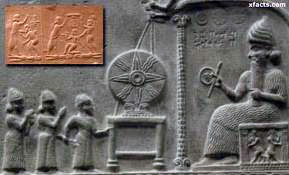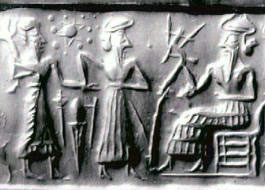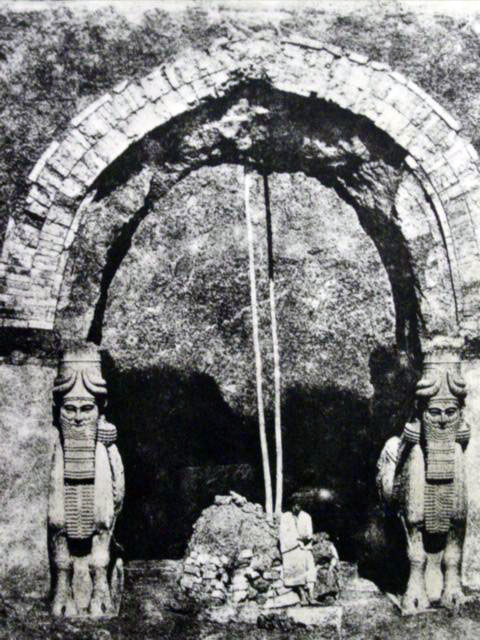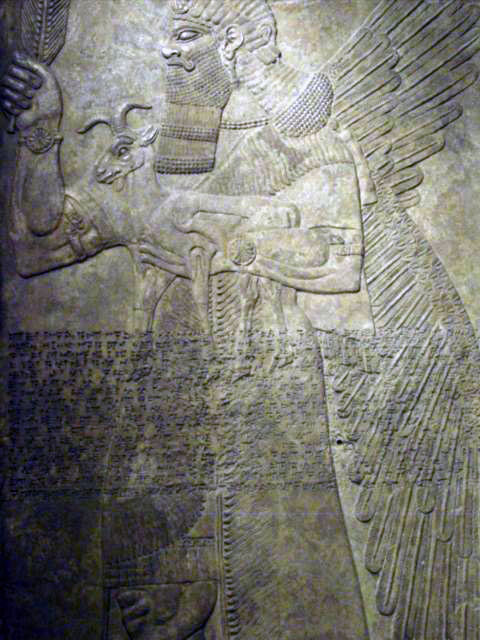|
|
There were Giants on the earth

And it came to pass,
When men began to multiply on the face of the Earth
and daughters were born unto them,
that the sons of God saw the daughters of men
that they were fair,
and they took them wives
of all which they chose.
There were giants upon the Earth
in those days and also thereafter too,
When the sons of God
came in unto the daughters of men
and they bare children to them—
the same Mighty Men of old,
Men of Renown.
The reader, if familiar with the King James English version of the Bible, will recognize these verses in chapter 6 of Genesis as the preamble to the story of the Deluge, the Great Flood in which Noah, huddled in an ark, was saved to repopulate the Earth.
The reader, if familiar with my writings, will also recognize these verses as the reason why many decades ago, a schoolboy was prompted to ask his teacher why it is "giants" who are the subject of these verses, when the word in the original Hebrew text is Nefilim—which, stemming from the Hebrew verb NaFoL, means to fall down, to be downed, to come down—and in no way 'giants'.
The schoolboy was I. Instead of being congratulated on my linguistic acumen, I was harshly reprimanded. "Sitchin, sit down!" the teacher hissed with repressed anger; "you don't question the Bible!" I was deeply hurt that day, for I was not questioning the Bible—on the contrary,
I was pointing out the need to understand it accurately. And that was what changed my life's direction to pursue the Nefilim.
Who were they, and who were their "Mighty Men" descendants?
The search for answers started with linguistic questions. The Hebrew text does not speak of "Men" who began to multiply, but of Ha'Adam—"The Adam," a generic term, a human species. It does not speak of the sons of "God," but uses the term Bnei Ha-Elohim—the sons (in the plural) of The Elohim, a plural term taken to mean "gods" but literally meaning "The Lofty Ones." The "Daughters of The Adam" were not "fair," but Tovoth—good, compatible . . . And unavoidably we find ourselves confronting issues of origins. How did Mankind happen to be on this planet, and whose genetic code do we carry?
In just three verses and a few words—forty-nine words in the original Hebrew of Genesis—the Bible describes the creation of Heaven and Earth, then records an actual prehistoric time of early Mankind and a series of amazing events, including a global Flood, the presence on Earth of gods and their sons, inter-species intermarriage, and demigod offspring . . .
And so, starting with one word (Nefilim), I told the tale of the Anunnaki, "Those who from Heaven to Earth came"—space travelers and interplanetary settlers who came from their troubled planet to Earth in need of gold, and ended up fashioning The Adam in their image. In doing so I brought them to life—recognizing them individually, unraveling their tangled relationships, describing their tasks, loves, ambitions, and wars—and identifying their inter-species offspring, the 'demigods'.
I have been asked at times where my interests would have taken me were the teacher to compliment rather than reprimand me. In truth, I have asked myself a different question: What if indeed "there were giants upon the Earth, in those days and thereafter too"? The cultural, scientific, and religious implications are awesome; they lead to the next unavoidable questions: Why did the compilers of the Hebrew Bible, which is totally devoted to monotheism, include the bombshell verses in the prehistoric record—and what were their sources?
I believe that I have found the answer. Deciphering the enigma of the demigods (the famed Gilgamesh among them), I conclude in this book—my crowning oeuvre—that compelling physical evidence for past alien presence on Earth has been buried in an ancient tomb. It is a tale that has immense implications for our genetic origins—a key to unlocking the secrets of health, longevity, life, and death; it is a mystery whose unraveling will take the reader on a unique adventure and finally reveal what was held back from Adam in the Garden of Eden.
Zecharia Sitchin
Looking for Alien DNA

Sitchin suggests that the star-shaped symbol and 11 other dots on this Sumerian cylinder seal, known as VA243, represent the sun, moon and 10 planets — including a mysterious world known as Nibiru.

He further suggests that beings from Nibiru made alterations in the human genome. Mainstream experts on Sumerian cuneiform texts say Sitchin's interpretation is wrong.
Zecharia Sitchin says he's willing to stake everything he's written about alien astronauts on DNA tests that could be performed on the 4,500-year-old remains of a high-ranking Sumerian woman. It's the latest - and possibly the last - cause célèbre for a fringe celebrity.
The way Sitchin sees it; the long-dead woman's genome could contain the signature of the gods and demigods he's been talking about since 1976.
The 90-year-old Sitchin was born in the Soviet Union grew up in Palestine and now lives in a New York apartment. He has written 14 books about way-out subjects, starting out with claims that a "12th planet" named Nibiru swung past Earth thousands of years ago and dropped off alien visitors who were looked upon as gods by Middle Eastern cultures. Sitchin says these aliens were the Annunaki mentioned in Sumerian scriptures, and the Nephilim mentioned in the Bible.
Needless to say, Sitchin's ideas - like those of another ancient-astronaut author, Erich von Däniken - have been roundly scorned by the scientific community. But now Sitchin is asking that very community to help him with the mystery of Queen Puabi.
Puabi's remains were unearthed from a tomb in present-day Iraq during the 1920s and 1930s, roughly the same time frame as the discovery and study of Tutankhamun's tomb in Egypt. Forensic experts at London's Natural History Museum determined that Puabi was about 40 years old when she died, and probably reigned as queen in her own right during the First Dynasty of Ur. Sitchin contends she was something more than a queen - specifically, that she was a "nin," a Sumerian term which he takes to mean "goddess."
He suggests that Puabi was an ancient demigod, genetically related to the visitors from Nibiru. What if these aliens tinkered with our DNA to enhance our intelligence - the biblical tree of knowledge of good and evil - but held back the genetic fruit from the tree of eternal life? Does the story of Adam and Eve actually refer to the aliens' tinkering? The way Sitchin sees it, the ancient myths suggest that "whoever created us deliberately held back from us a certain thing - fruit, genes, DNA, whatever - not to give us health, longevity, and the immortality that they had. So what was it?"
Sitchin wants scientists to test the DNA from Puabi's remains, just in case it holds the answer. "Maybe by comparing her genome with ours, we would find out what are those missing genes that they deliberately did not give us," he told me. "Maybe. I cannot guarantee that, but maybe."

